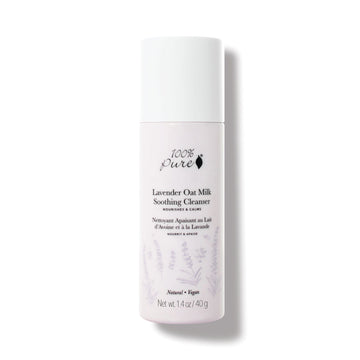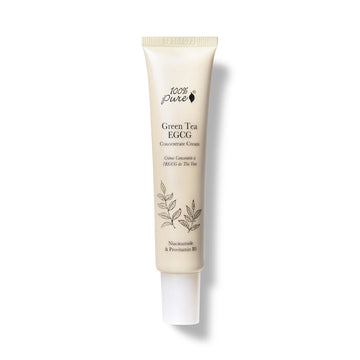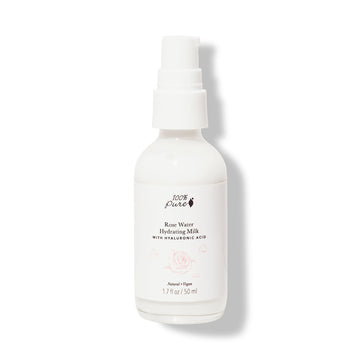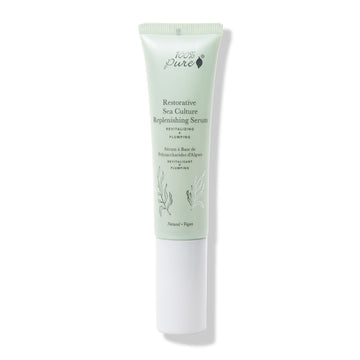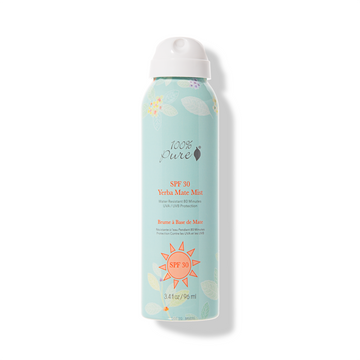Mastering Rosacea Management in Chilly Weather
Posted on October 19, 2024 Written by: 100% PURE®
Blushing from embarrassment or after intense cardio is fine, but persistent facial redness can be just plain maddening and a red flag for having rosacea – insert fuming red-faced emoji! Adding to the madness is the blistering wains and pains of the colder months and you have a dual struggle to adjust to ye olde winter!
Now, while Rudolph and Santa’s red nose may be beady and darling, many skin warriors with rosacea may find their persistent red-tinged facial areas sans cute and buttony. And, just as winter can bring snow to places where you’d least expect it, the colder months bring a snow mound of frustration with unpredictable flare-ups.
We know it doesn’t take long for temps to drop in the frosty months, and the same is true with the increase of rosacea symptoms as the mercury plummets. But have no frosty fear – we have effective strategies for winter rosacea management. It’s time for winter skincare to help you light the way to calmer, healthier skin.
Understanding Rosacea and Cold Weather
Does your face flush or blush easily, and then stay that way for a while? It’s common after cardio or cocktails, but long-term redness combined with visible blood vessels in your face sufferers, acne-like pustules, or a hereditary disposition could mean something more: rosacea.
Rosacea is a common, chronic skin condition that most often involves the nose, cheeks, forehead, and chin. The affected skin might be thickened or swollen, and have small, red, pus-filled bumps. These can often be mistaken for acne, eczema, or a skin allergy.
The National Rosacea Society notes that it’s estimated that 16 million people in the country – mostly middle-aged women – have rosacea, which is often characterized by flare-ups and remissions. Now, ladies, you may be seeing red about that fact, but let’s first delve into the different types of rosacea to determine how you can seize your skin back.
There are four types of rosacea: erythematotelangiectatic (vascular), papulopustular (inflammatory), phymatous, and ocular. Let’s discuss the characteristics of each type.
Erythematotelangiectatic Rosacea: This type of rosacea is characterized by persistent skin redness or discoloration, flushing, and visible blood vessels Without treatment, the redness can get more persistent, cover more skin, and even become permanent.
Papulopustular Rosacea: This form is associated with “whitehead” pustules, which are pus-filled blemishes, and red, swollen bumps. These typically appear on the cheeks, chin, and forehead and are frequently misidentified as acne.
Phymatous Rosacea: This type of rosacea causes the skin to thicken and scar, making it bumpy, swollen, and sometimes discolored.
Ocular Rosacea: This form of rosacea affects your eyes and eyelids, causing them to become red and irritated. It can cause persistently dry, sensitive eyes, and cysts may form on the eyelids.
With the different forms and complexities of rosacea, it should come as no surprise that the exact cause of the inflammatory skin condition is unknown. There’s rather an intricate interplay of hereditary, vascular, immune, and environmental factors that may be involved. Some common triggers and symptoms of rosacea include:
#1. Immune responses: Inflammatory and immune responses may be involved in rosacea. A disorder of the neurovascular system (nerves, veins, arteries) may cause rosacea.
#3. Genetic predisposition: Your genes may play a role in the development of rosacea. If either of your parents has rosacea, you may have a hereditary disposition to the chronic skin condition.
#4. Environmental factors: Exposure to ultraviolet (UV) radiation from the sun, heat, and certain microbes that live on the skin may contribute to rosacea. Microscopic skin mites called Demodex, which is more abundant where there is rosacea and may contribute to the condition.
#5. Skin sensitivity: People with rosacea may have increased skin sensitivity. For example, people who have fair skin and who tend to blush easily, or of northern European ancestry, may also be at a higher risk for the disorder.
Going back to the dual skin struggle we mentioned earlier, it’s maddening enough to cope with and treat rosacea, but when you add Jack Frost to the messy mix, winter takes more of a skin-mageddon on the delicate state of your rosacea. There are a few important factors in how cold weather affects rosacea:
Dryness: The lack of humidity in the frosty air dries out the skin, which can leave your complexion feeling tight and itchy. Cold, dry air can also dehydrate the skin, making it more prone to irritation and inflammation.
Temperature changes: In winter the temperature also drops bringing chilly, dehydrating winds that blow harshly on the skin, sucking up every bit of hydration. The shock of going from cold, dry air outside to warm, humid air inside can trigger vasodilation, which causes redness and flushing.
Indoor heating: Artificial heat can dry out the skin. All that cozying by the fire and bumping up the thermostat has a hidden consequence: drying out our skin. Our delicate dermis could fall into the blustery realm of increased redness, irritation, and inflammation.
Holiday indulgences: Spicy foods, hot drinks, wine, and alcohol can trigger rosacea.

Identifying Cold Weather Rosacea Triggers
Winter, with its unique – and challenging - climatic conditions, can have a profound impact on rosacea. As the mercury drops, the characteristics of how rosacea-prone skin changes, necessitating a shift in our general winter habits. Let's explore how the cold weather and associated lifestyle changes can trigger rosacea.
Environmental factors
Harsh winds and low temperatures: One of the most significant challenges during the colder months is the harsh combination of low temperatures and harsh, dry winds. This duo can be particularly unkind to rosacea. People with rosacea might notice a worsening of their symptoms. The low humidity levels outside and the biting cold strip the skin of its natural oils, which are essential for maintaining moisture.
This loss of moisture often leads to dryness, a feeling of tightness, and sometimes even flaking. The skin's barrier function can be compromised, making it more vulnerable to irritants and pathogens. As the skin loses moisture, it can become more than just uncomfortably dry; it can get even more irritated and inflamed.
Dry air from indoor heating: While retreating indoors seems like a logical escape from the cold, the indoor environment during winter can also adversely affect rosacea. Indoor heating systems, while essential for our comfort, exacerbate the problem of dry air. Heating systems often reduce the indoor humidity level, creating an environment that can further sap moisture from our skin.
This constant transition from the cold outdoors to the heated indoors can cause the skin to lose its natural balance, leading to dehydration. The dry, warm air indoors not only pulls moisture from the skin but can also lead to a more irritated and inflamed complexion.
Dietary considerations
If you love spicy dishes that draw tears, you could end up with tears of frustration from a rosacea flare-up. Spicy foods, hot drinks, alcohol, and vino – especially red wine – can aggravate rosacea and trigger blotchy skin on the face. It may be time to find better replacements to please your palette.
PRO TIP: If your red skin is accompanied by itching or burning after drinking wine, it might be more than blotchy skin – you could have a wine allergy. Oh, the horror!
Spicy foods and hot drinks:
Spicy foods contain chemicals that increase blood flow and interact with skin heat receptors, which can cause redness, irritation, and inflammation. Hot drinks raise body temperature and trigger flushing. Hot water can also trigger flushing and redness.
Alcohol consumption during holiday seasons:
After the end of a day with the hustle and bustle of hectic holiday shopping, it’s nice to relax with your favorite alcoholic beverage; that is until you discover it exasperates your rosacea. Alcohol can worsen rosacea because it dilates blood vessels in the skin, which increases blood flow and causes a flare-up. Alcohol can also increase inflammation and change the gut microbiome.
Stress and lifestyle factors
Stress and various lifestyle factors like poor sleep quality can significantly worsen rosacea by triggering inflammation in the body, leading to facial flushing and redness, which are the primary symptoms of the condition; this is because stress causes the release of hormones like cortisol, which can exacerbate the skin's sensitivity and blood vessel dilation associated with rosacea. Trust us, we know it’s hard – but try being mindful about your stress levels and lifestyle factors.
Holiday-related stress: Fa-la-la-la…blah! Yes, stress from the holidays can make rosacea worse. Stress can trigger rosacea flare-ups, and rosacea symptoms can also cause stress. This can create a cycle where the fear of turning red leads to more redness, which causes more anxiety.
Changes in sleep patterns:
Rosacea patients have a higher prevalence of poor sleep quality than healthy people, and the severity of rosacea is linked to poorer sleep quality. Poor sleep can trigger rosacea through inflammatory and stressful conditions. Moreover, as your body temperature fluctuates while you sleep, you may find that a sudden spike results in a rosacea flare-up.
Balancing Skin Protection and Winter Activities
Many people with rosacea are well aware that the heat is their skin-emy. Staying out of the hot gaze of the sun and keeping cool with shade and water are basic tenets of rosacea control. So, it’s no wonder that rosacea patients breathe a sigh of relief at winter’s arrival – or do they?
But just because the weather is cool doesn’t mean rosacea that those with rosacea-prone skin can slack off in the winter. If you have this condition, you should adjust to the new set of challenges this season brings. The key to managing rosacea is to balance skin protection with winter activities – and not hibernate from them.
Desire to enjoy winter activities vs. fear of flare-ups:
Winter activities can be a double-edged sword for rosacea. The cold gusts of wind and the dry air can really do a number on rosacea-prone skin. It strips away the protective barrier and irritates the skin, potentially causing flare-ups. To protect against this, wear protective clothing, including a scarf, hat, eyewear, and SPF when spending a long time outdoors. Don’t let the fear of a flare keep you from reaping the many benefits of staying active.
Struggle with maintaining a normal lifestyle during flare-ups:
The struggle is real for rosacea warriors. Trust us, we know it’s hard – but try being mindful about balancing a rosacea flare-up with your current lifestyle. Give yourself permission to take the cautionary steps to try to sustain a normal lifestyle with a rosacea flare-up. But you can also step back from the norm to do something you enjoy. Tap out for a short time to read a book, take a relaxing bath, or for a hobby. Keep a positive attitude, as stressing about a flare-up can make it worse. Moreover, get some exercise. It can be as simple as going for a walk. Being outside in nature is very therapeutic.
Emotional impact of rosacea exacerbation in social settings:
Rosacea can have a significant emotional impact on people, especially in social situations. People with rosacea may feel embarrassed about their facial appearance, which can lead to avoiding social situations. If comfortable, explain your rosacea to people you spend time with, so they understand why your skin might appear flushed and avoid making assumptions about your health habits. Remind yourself that your rosacea doesn't define you and focus on your positive qualities. You can also use gentle, well-suited makeup to cover redness and even out skin tone, enhancing your confidence.
The Winter Rosacea Solution: Effective Management Strategies
Giving your skin effective strategies in the winter months is key for helping to manage the symptoms of rosacea. With the ultra-stripping wind chill, lower levels of humidity in the air, super stuffy, overheated office spaces, and indoor climates, the winter months are a minefield for your delicate dermis. We’ve put together some solutions and strategies to help you manage your rosacea flare-ups through the blusteriest of seasons!
Protective skincare routine:
Giving your skin a protective natural skincare regimen in the winter months is key for keeping rosacea flare-ups at bay. With the ultra-stripping wind chill, lower levels of humidity in the air, super stuffy, overheated office spaces, and indoor climates, the winter months are a minefield for your delicate dermis. Here are some tips to get your skin safely through the blusteriest of seasons!
Gentle, non-irritating cleansers
The foundation of a healthy skin barrier starts with how you cleanse your skin. Using a gentle, non-irritating, or skin-stripping cleanser ensures that your skin is cleansed without stripping away its natural oils. Harsh cleansers can remove essential lipids and proteins that make up the skin barrier, leading to dryness and irritation – and exasperating your rosacea.
Barrier-repairing moisturizers
Adding products with barrier-repairing ingredients like ceramides, niacinamide, and fatty acids is essential for skin health. Moisturizers packed with antioxidants and anti-inflammatory properties that aid in repairing and strengthening the skin barrier are ideal for rosacea-prone skin. These ingredients work by replenishing the lipids in the skin and reducing inflammation, thereby enhancing the skin’s ability to retain moisture and protect against environmental stressors during winter.
Importance of sun protection even in winter
UV rays are one of the most significant contributors to rosacea flare-ups. Regular use of sun protection is essential for maintaining a healthy skin barrier and keeping those pesky flare-ups at bay. Remember, the sun reflects off the snow, making it very important to protect your delicate dermis.
Lifestyle adjustments:
Protecting skin from extreme temperatures
Frigid winds and humid weather can also worsen the appearance of red, suffering skin. It’s important to layer on SPF even in the winter months, especially to avoid the reflective rays from the snow - as well as layering up on protective gear in extreme cold weather.
Humidifier use for indoor moisture balance
It’s not just the cold that’s drying out your skin during the winter, it’s also the dry air your heater puts out, especially while you’re sleeping. Luckily, there’s an easy fix for this. Investing in a humidifier can not only give you a better night’s sleep but also help keep your skin from the drying effects of indoor heating and cut down on the frequency of rosacea flare-ups.
Stress-reduction techniques
Stress is a common trigger for rosacea flare-ups, and there are many ways to reduce it. Practice mindfulness; try meditation, yoga, or tai chi. As we mentioned earlier, regular physical activity can help relieve stress. You can try going for a walk or dancing to music. Do something you enjoy, like reading a book or taking a bath. In stressful moments, try taking a deep breath, holding it, and then exhaling slowly.
Medical treatments:
Topical medications for flare-up control
Available over-the-counter as a gel or lotion, Azelaic acid is one such natural remedy that can reduce inflammation and prevent pores from clogging. It can be applied once or twice a day and can help decrease facial redness.
Oral antibiotics or other prescriptions when necessary
For more serious rosacea, you may need to be prescribed antibiotics or a prescription cream from a board-certified dermatologist.

100% PURE Rosacea-Friendly Winter Products
When life gets hectic, especially during the busiest shopping season of the year, many tend to get a little lax with their skincare routine. With rosacea, the skin’s outer layer is usually impaired, leaving it vulnerable to irritants. Since rosacea can react negatively to harsh ingredients, stick with gentle beauty and skin care products. Stay away from over-exfoliating, chemical peels, and harsh alcohols.
Lavender Oat Milk Soothing Cleanser
Picture this: A gentle massage with a powder cleanser that reminds you of lavender fields and a warm oatmeal bath. This gentle cleanser is exactly that and more. Colloidal oatmeal's moisturizing properties, combined with the deep purification of lavender oil, oat milk, and the restorative magic of echinacea, make this product a must-have for comforting sensitive skin.
Green Tea EGCG Concentrate Cream
Formulated with green tea's superhero ingredient, this cream is your skin's best friend when it comes to defending against environmental damage, harsh weather, and skin sensitivities.
Nothing quenches the skin's thirst quite like rose hydrosol and hyaluronic acid. This ultra-lightweight liquid moisturizer is like a gentle caress of rose petals, hydrating and calming the skin. Perfect for those days when your skin feels parched, this cleansing milk is the hydration boost you didn't know you needed.
Restorative Sea Culture Replenishing Serum
This ultra-light gel serum is designed to saturate dry, thirsty skin cells with intense nutrition and hydration. Harnessing the power of mineral-rich sea kelp and algae extract – with help from hyaluronic acid – this hydrating serum delivers plump and supple skin, with a lessened appearance of redness and irritation.
The hero product for sun protection. Find your perfect mate with this lightweight mist made with nourishing yerba mate. Like our fave green tea, yerba mate leaf is antioxidant-rich for protection against free radicals that cause UV damage and signs of premature aging. Safflower seed oil has a light floral scent that also soothes and conditions your skin.
Conclusion
Winter, with its serene snow-covered landscapes, glistening, candy canes, and silver lanes, is undeniably a season to cherish. However, amidst the cold, the cozy fires, and the hot chocolate, our skin often silently battles the brunt of the season’s dryness and harshness, especially if you have rosacea. Rosacea is one of the most common skin conditions. While it is a chronic inflammatory disorder, there are various ways to treat and reduce symptoms.
While adjusting our daily routines and embracing healthier lifestyle choices play a significant role, sometimes the journey to winter skin radiance requires adapting the proper skincare routine and effective strategies to manage rosacea flare-ups.
We hope our tips and natural products will help you curate the best rosacea winter skincare routine. These healing, soothing, and protective ingredients should have you on your way to happy, healthy skin by the lead of Rudolph’s nose and the jingle of Santa’s reindeer. We can save that redness for Santa’s cheeks!
Frequently Asked Questions
Can rosacea worsen permanently if not managed properly in winter?
The dryness and redness caused by rosacea can be made worse in the cold, winter months. This dry air and winds are one of the most common triggers of rosacea flare-ups. By continuing to not have a winter skincare routine, your rosacea can worsen or even become permanent.
Are there any specific fabrics I should avoid wearing to prevent flare-ups?
Some fabrics can set off flares, either because they trap heat (polyester), or irritate skin (wool). Stick to 100% cotton, bamboo, or silk clothing as you build your wardrobe.
How can I distinguish between rosacea flare-ups and normal skin reactions to cold?
To differentiate between a rosacea flare-up and a normal skin reaction to cold, look for persistent facial redness that lingers even after warming up, visible blood vessels, bumps or pimples on the face, a burning or stinging sensation, and a tendency to flush easily, which are all more indicative of rosacea, while a normal cold reaction usually presents as temporary redness that quickly subsides once you come indoors and warm up; if you experience significant redness, itchiness, or welts after cold exposure, it could be a sign of a cold allergy (cold urticaria) and not just a normal reaction.
Is it safe to use facial oils if I have rosacea-prone skin?
While using facial oils on rosacea-prone skin is possible, it's crucial to choose oils carefully, opting for non-comedogenic options like jojoba, rosehip, argan, apricot, or squalane, as they are less likely to clog pores and irritate sensitive skin; always do a patch test first and consult a dermatologist if you have concerns about using facial oils with rosacea.
Can indoor exercise help or worsen rosacea symptoms in winter?
Indoor exercise in the winter can worsen rosacea symptoms if the room is too warm, as increased body temperature from exercise combined with heated indoor air can trigger flushing and flare-ups; therefore, it's important to keep the room cool and well-ventilated to minimize rosacea aggravation.
- Tags: October-2024, Skin Care, skincare
We carefully hand-select products based on strict purity standards, and only recommend products we feel meet this criteria. 100% PURE™ may earn a small commission for products purchased through affiliate links.
The information in this article is for educational use, and not intended to substitute professional medical advice, diagnosis, or treatment and should not be used as such.












